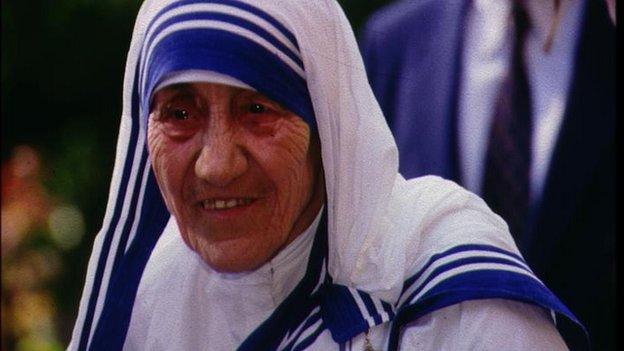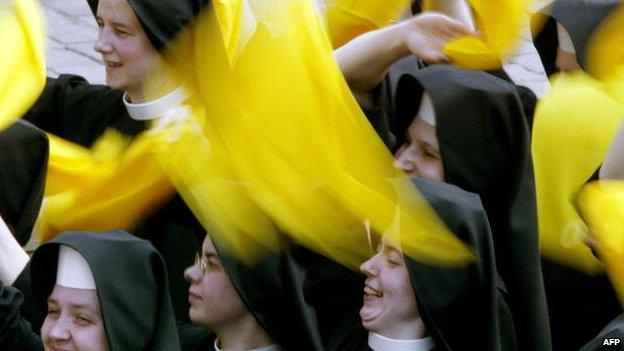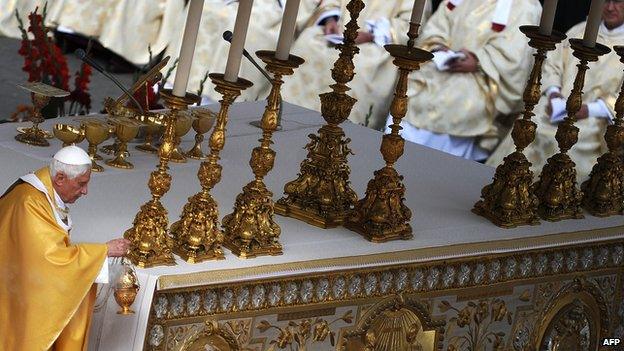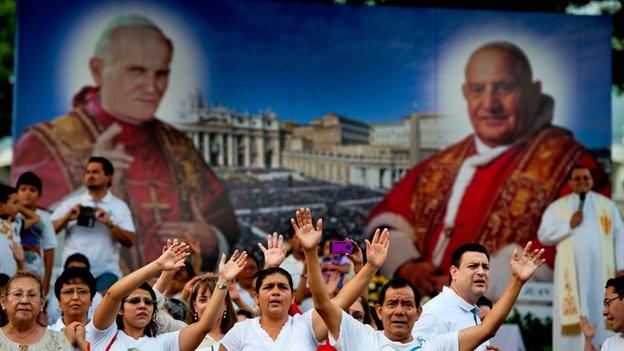How does someone become a saint?
- Published

Pope Francis has officially named the world famous nun, Mother Teresa, a saint.
Mother Teresa, who died in 1997, spent her life helping poor people in the slums in India. She's become "Saint Theresa of Calcutta" in a special ceremony.
Being named a Saint is seen as being a religious honour given to people after they've died.
But how does someone become a saint in the eyes of the Vatican - the headquarters of the Roman Catholic Church?

Mother Teresa has been named a saint

Step one: Wait five years - or don't
The process to make someone a saint cannot normally start until at least five years after they have died.
Some have had to wait a long time before reaching Catholic sainthood. Saint Bede, the theologian, died in 735 but it was 1,164 years before he was declared a saint.
.jpg)
St Bede died in 735 and was canonised in 1899
The waiting time can, however, be changed by the Pope.
For example, Pope John Paul II didn't wait five years with Mother Teresa, beginning the process in 1999, less than two years after her death.

Step two: Become a 'servant of God'

Canonisation ceremonies are greeted with joy by many Catholics
Once the five years are up the bishop where the person died can open an investigation into the life of the individual, to see whether they lived their lives with enough holiness and virtue to be considered for sainthood.
Other religious groups can also ask the bishop to open the investigation.
Evidence is gathered on the persons' life, and some people are asked to give statements about them.
If there is enough evidence, the bishop asks the 'Congregation for the Causes of Saints', the department that advises the Pope on saints, for permission to open the case.
Once the case is accepted for consideration, the individual can then be called a "servant of God".

Step three: Show proof of a life of 'heroic virtue'
.jpg)
Evidence is looked at by Catholic Congregations and the Pope before a person is given the "venerable" title
The 'Congregation for the Causes of Saints' looks at the examples of the candidate's holiness and the work that they've done in their life.
If the Congregation approves the case it's then passed to the Pope.
If the Pope decides that the person lived a life of "heroic virtue", they are then called "venerable".
Popes who have been given the title of "venerable" include Paul VI and Pius XII.

Step four: Miracles
The next stage is called beatification, or declaring a person "blessed".
For this a miracle needs to have happened as a result of someone praying to the candidate after they have died.
Prayers being granted is seen as proof that the candidate is already in heaven, and able to speak to God on behalf of others.
.jpg)
Beatification ceremonies can draw huge crowds
Any examples of prayers being granted need to be proved by the Vatican, with evidence, before they are accepted as miracles.
After beatification, the candidate is given the title "blessed".
There is one exception to the miracle requirement - a martyr, someone who died for their faith, can be beatified without a proved miracle.

Step five: Canonisation

Canonisation ceremonies involve a special Mass that looks at the individual's life
Canonisation is the final step in declaring a person a saint. To reach this stage, a second miracle normally needs to be proved.
Martyrs, however, only need one miracle to become a saint.
During the canonisation ceremony, the Pope leads a special Mass, reading out the history of the individual's life and then chanting a prayer in Latin declaring the person a saint.
Canonisation ceremonies can attract huge audiences.

- Published27 April 2014

